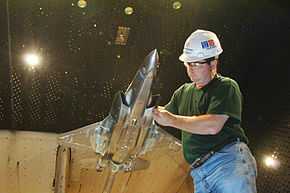Arnold Engineering Development Complex
Arnold Engineering Development Complex
 | |
|---|---|
|
An F-35 Lightning II Joint Strike Fighter model in the Arnold Engineering Development Center's 16-foot transonic wind tunnel | |
| Active | 1950–present |
| Country |
|
| Branch |
|
| Role | Test facility |
| Part of | Air Force Test Center Air Force Materiel Command |
| Garrison/HQ | Arnold Air Force Base, Tennessee |
| Nickname | AEDC |
| Patron | Gen Henry "Hap" Arnold |
| Decorations | Air Force Organizational Excellence Award |
| Commanders | |
| Commander | Col Raymond G. "Buzz" Toth |
| Executive Director | Douglas C. Blake |
| Insignia | |
| Arnold Engineering Development Complex emblem |
 |
Arnold Engineering Development Complex (AEDC), Arnold Engineering Development Center before July 2012, located at Arnold Air Force Base, Tennessee is a ground-based flight test facility operated by the Air Force Test Center.[1]
The AEDC mission is to test and evaluate aircraft, missile and space systems and subsystems at the flight conditions they will experience during a mission; conduct a research and technology program to develop advanced testing techniques and instrumentation and to support the design of new test facilities and maintain and modernize the center’s existing test facilities.
Staff agencies
- Test Division
- Turbine Engine Ground Test Complex
- AEDC Sea Level Test Cells
- Aero-propulsion Systems Test Facility
- AEDC Engine Test Facility
- Propulsion Wind Tunnel Ground Test Complex
- Space and Missile Ground Test Complex
- AEDC Space Chambers Test Facility
- High-Enthalpy Arc Heated Facility
- Aero-ballisitc Range Facility
- Aerodynamic and Propulsion Test Unit
- Turbine Engine Ground Test Complex
- Maintenance Division
- Support Asset Branch
- Test Asset Branch
- Mission Support Division
- Communications Branch
- Civil Engineer Branch
- Services
- Test Systems Division
- Technology Branch
- Investments Branch
- Management Operations
Environmental Issues
Several areas of the facility are contaminated by substances including polychlorinated biphenyls (PCBs) and volatile organic compounds and spills of jet and rocket fuel, chlorofluorocarbon solvents, nitric acid and other materials. PCBs from the site have been detected in local creeks, in the water, sediment and in fish.[2]
The site was proposed for addition to the Superfund National Priorities List in August 1994 though, as of May 2010, the site has not been added to the NPL.[3] The Environmental Protection Agency believes that human exposure to contaminants and contaminated groundwater migration are under control.[3]
External Facilities
- The Hypervelocity Wind Tunnel 9 is located in Silver Spring, Maryland
- The National Full-Scale Aerodynamics Complex (NFAC) is located at NASA Ames Research Center, Moffett Field, California. The NFAC was closed by NASA in 2003. In February 2006, AEDC entered into an agreement with NASA to lease the facility for a period of up to 25 years.
History
Originated in 1950, the center operates 58 aerodynamic and propulsion wind tunnels, rocket and turbine engine test cells, space environmental chambers, arc heaters, ballistic ranges, and other specialized units. Currently, AEDC's prime contractor is the Aerospace Testing Alliance.
The center has helped to develop most aerospace systems in the U.S. government's inventory, including the Atlas, Titan, Minuteman and Peacekeeper ICBMs, the Space Shuttle, space station, and Projects Mercury, Gemini and Apollo.[4]
It is named for General Henry "Hap" Arnold, the father of the US Air Force and an air power visionary. The University of Tennessee Space Institute (UTSI) is located adjacent to AEDC.
The center lies near Manchester, Tennessee and Tullahoma, Tennessee, and occupies much of the site of the former Camp Forrest, a U.S. Army base and World War II POW camp. It is unique in that the majority of the workforce are contract personnel, with a small contingent of active-duty assigned.
Lineage
- Constituted as the Air Engineering Development Division on 1 January 1950 and activated
- Redesignated Arnold Engineering Development Center on 3 August 1951
- Redesignated Arnold Engineering Development Complex on 6 July 2012
Assignments
- United States Air Force: 1 January 1950
- Air Research and Development Command (later Air Force Systems Command), 1 May 1951
- Air Force Materiel Command, 1 July 1992 (attached to Air Force Test Center after 6 July 2012)
- Air Force Test Center, 1 October 2012
Stations
- Arnold Air Force Station (later Arnold Air Force Base), 1 January 1950 - present
Components
- 704th Maintenance Group, 1 June 2006 - 30 June 2010
- 704th Mission Support Group, 1 June 2006 - 30 June 2010
- 704th Test Group, 1 June 2006 - 30 June 2010
- 704th Test Systems Group, 1 June 2006 - 30 June 2010
- 6560th Air Base Squadron (later 4960th Air Base Squadron, 4960th Air Base Group, 656th Support Squadron, 656th Air Base Squadron), 8 May 1951 - c. 1997
See also
References
Notes
- ↑ Arnold mission becomes part of Air Force Test Center
- ↑ "NPL Site Narrative for Arnold Engineering Develop. Ctr. (USAF)" (PDF). EPA. Retrieved 2010-05-06.
- ↑ 3.0 3.1 "Arnold Engineering Development Center (USAF) Superfund Site Progress Profile". EPA. Retrieved 2010-05-06.
- ↑ "ARNOLD ENGINEERING DEVELOPMENT COMPLEX".
Bibliography
![]() This article incorporates public domain material from the United States Government document "Arnold Engineering Development Center".
This article incorporates public domain material from the United States Government document "Arnold Engineering Development Center".
![]() This article incorporates public domain material from websites or documents of the Air Force Historical Research Agency.
This article incorporates public domain material from websites or documents of the Air Force Historical Research Agency.
External links
- Arnold Air Force Base (official)
- Arnold Air Force Base at GlobalSecurity.org
- University of Tennessee Space Institute
| |||||||||||||||||||||||||||||||||||||||||||||||
| ||||||||||||||||||||||||||||||||||||||||||||||

